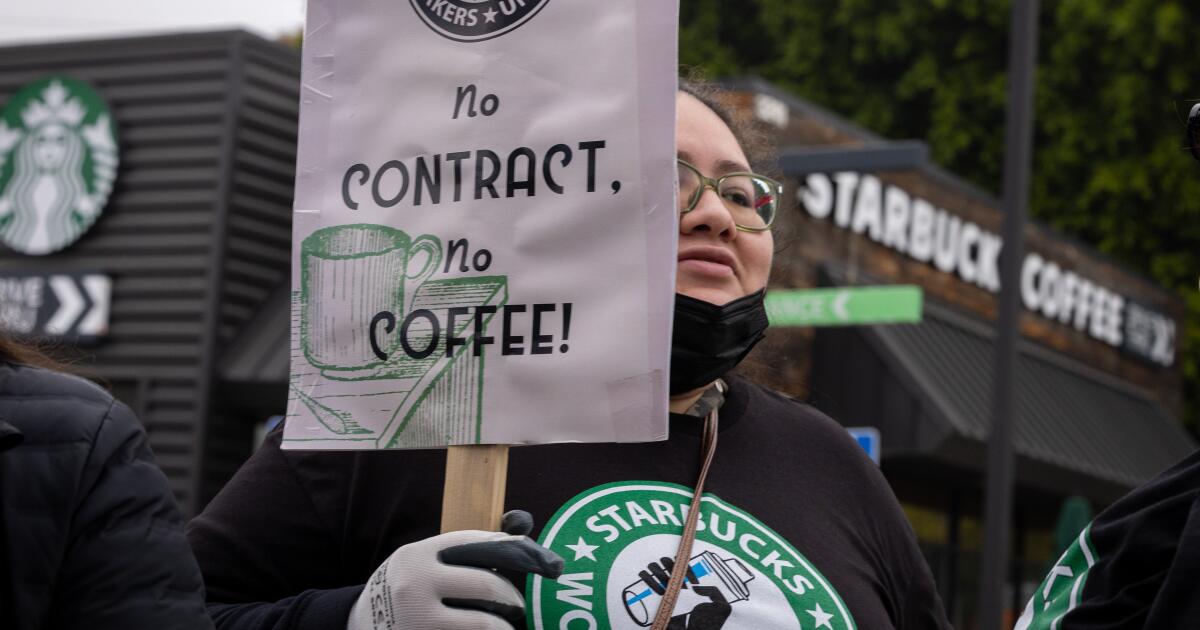The Starbucks union went on strike at dozens of stores on Red Cup Day

The union representing Starbucks baristas began an open strike at stores in more than 40 cities on Thursday, coinciding with Red Cup Day, one of the coffee giant’s most profitable sales days of the year.
The Starbucks workers’ union said more than 1,000 baristas at about 65 stores were involved as of Thursday morning, but threatened to quit if contract talks that have been ongoing for years do not make progress.
The unionized workers say they are striking for better take-home pay, predictable scheduling and to resolve hundreds of unfair labor practice charges workers have filed against the company with federal regulators in recent years.
“We’re trying to cope,” Jeremiah Pitts, a barista at the Starbucks location at Downtown Disney in Anaheim, said in an emailed statement. “Starbucks knows where we stand. They know our demands. The ball is in their court.”
The Downtown Disney store began its strike on Nov. 8, a few days earlier than other locations, as a result of tensions between management and unionized workers, the union said. It declined to give details on what specifically prompted the initial move.
According to the union, the strike so far includes about 10 stores in California, including locations in Anaheim, Long Beach, San Diego, Santa Clarita, Santa Cruz, Scotts Valley, Seal Beach and Soquel.
Although Starbucks said it sees minimal impact from the operation, the move could disrupt business during Starbucks’ busy holiday season. The company is likely relying on sales to improve its performance under CEO Brian Nicol, who took the helm last year.
The company has struggled in recent years, with several changes in leadership, softening demand and Boycott About his significant support for Israel. But in its latest quarterly earnings, the company posted a 1% increase in global same-store sales, ending a two-year streak of declines. However, sales in US stores remained flat.
“We still have a lot of work ahead of us, but it’s clear we’re headed in the right direction,” Nicol said during a recent call with investors.
On Thursday, Starbucks spokesman Jesse Anderson said 99% of the company’s locations in the United States were not affected by the strike.
“The day is off to an incredible start – based on what we saw this morning, we are on track to exceed our sales expectations for the day at company-operated coffeehouses in North America,” Anderson wrote in an email.
On Red Cup Day at the company’s market, customers who order a holiday-themed drink, such as the popular Pumpkin Spice Latte, receive a free limited-edition reusable red cup.
The action comes after union workers voted last week to authorize a strike, a move that was approved by 92% of the public, according to the union.
After a wave of organizing at Starbucks stores took the United States by storm in late 2021, the company launched a strong campaign of opposition, leading to hundreds of lawsuits filed by workers. Federal regulators have repeatedly found that Starbucks violated labor laws by disciplining and firing workers, engaging in union activity, closing stores and delaying contract negotiations.
Early last year, however, the company changed its tune, pledging to work with the union. But the talks failed again last winter and the talks have been at a standstill for six months.
John Logan, director of labor and employment studies at San Francisco State University, said that while the company’s former CEO Laxman Narasimhan has taken steps toward better relations with the union, Nicholl, in stark contrast, “doesn’t seem particularly interested in making a deal.”
Starbucks Workers United says it represents 12,000 workers at about 650 coffee shops. The company disputes the union’s numbers, saying it represents nearly 9,500 workers at 550 stores, or about 4% of Starbucks’ U.S. workforce.
The coffee chain is now taking a more aggressive approach in its public messaging against the union, with company spokesman Anderson, suggesting without evidence that the union formed picket lines with only paid union workers, rather than actual baristas.
The union said in a statement that Starbucks’ claims that it had asked for a 65% pay increase – which its CEO characterized as an unrealistic demand – were “false and out of date”, saying the company was wrongly combining various economic proposals from the union to arrive at the figure.
Todd Vachon, assistant professor of management and labor relations at the Rutgers School of Management, said that although only a fraction of Starbucks locations are unionized, the strike may still have high visibility, especially in the retail and service industries concerned with the relationship between employees and customers.
“It embarrasses a potentially powerful weapon in the Union’s arsenal,” Vachon wrote in an email.
The union had already sought to take advantage of the busy holiday season, initiating a five-day work stoppage leading up to last Christmas Eve.
Michelle Eisen, a former Starbucks employee and union spokesman, said the Red Cup Day disruption was “just the beginning.”
“If Starbucks continues to unionize baristas, we are poised to make this the largest, longest strike in the company’s history during the critical holiday season,” she said during a news conference Thursday.




Post Comment